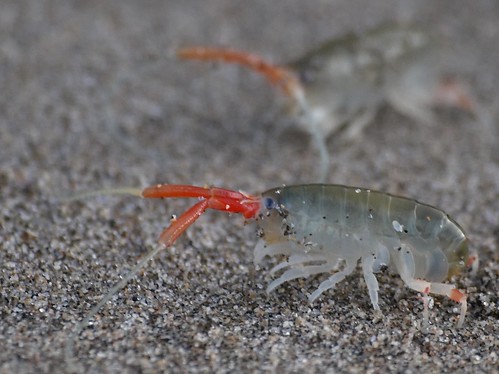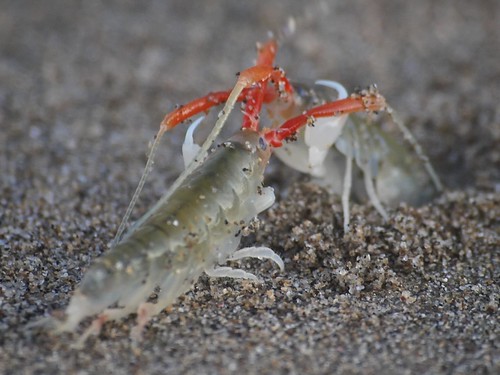California Beach Hopper or Megalorchestia californiana
As fleas go, they’re giants. Not giants in the sense of Bikini-Atoll-nuclear-mutant-gone-bad giants. But by flea standards, they’re positively huge — about 1 inch long. That’s probably because they’re not parasitic dog or cat fleas, but rather, amphipods — shrimp-like creatures who dine on organic matter at the outer limits of the tideline.
This was our first face-to-face with a beach flea, also known as the California Beach Hopper. It was sunrise on a Mendocino Beach with a -2.1 tide — a beach surprisingly devoid of abalone divers along a coastline literally trampled by them.
In our solitude, we had the time and space to look between our toes. And for the squeamish, what we saw was squirm worthy: hundreds of translucent flea-like figures hopping and falling in the sand around us. Fortunately, Shrimp People don’t make me squirm.
They might as well be drunk the way they hop and stumble. I know this because I was flat on the sand, watching them through my telephoto as they jumped, then tumbled, jumped then tumbled. And as they fell, invariably, another Beach Hopper would arrive to challenge the fallen flea. A scuffle of sorts would ensue, and then each beach flea would move on. The Beach Hoppers with burrows weren’t immune from intrusion either, as this photo establishes:
I confess that I can’t distinguish between amiable and antagonistic actions of beach fleas, but my understanding is that mating occurs in the burrow, and that what I was seeing outside probably constituted territorial exploration and arguments over burrows.
Beach Hoppers were at this spot because it happened to be on the cusp of the high-tide seaweed line. They dine upon elements of seaweed. They’re normally out and about at night — sometimes in the early morning hours. They themselves become food for animals like shorebirds, so the acquisition of a burrow is undoubtedly high on the priority list.

Megalorchestia californiana Heading Home - ©ingridtaylar
Related posts: A Budding Amphipodologist




[…] hide in the wrack. Since I couldn’t find any, I checked out Ingrid Taylar’s wonderful photos of the California beach hopper from Mendocino Beach, […]
[…] Encounters With [the Elusive] California Beach Hopper […]